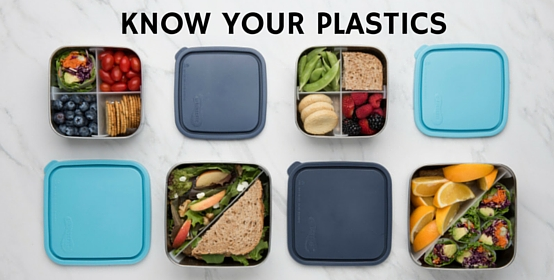
By 2050 we will have more plastic in our oceans than life in our oceans. How many of us think do I really need that plastic packaging? Is this plastic recyclable? This plastic that I have bought, where will it end up? It's about time we start thinking about how we buy, use and eventually dispose of plastic.
In today's wastemanagement Wednesday we will go through the different types of plastics, and some safety tips in the end. Let's start, Shall we?
1. PET or PETE
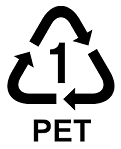
Characteristics of PET
- PET doesn't react with water or food which is why it's commonly used for consumable packaging.
- It's very strong for its light weight, which means less material is required for use such as plastic film for packaging.
- It's shatterproof making it a great alternative for glass as a container.
- Has a very high melting point (>200 deg), and it being a thermoplastic it can melt and still retain its chemical properties.
**Typical uses of PET **: Packaging for soft drinks, water, sports drinks, ketchup, salad dressing and in the textile industry it's commonly known as polyester.
**Environmental Impact **: Moderate Hazard as it's non-biodegradable but easy to recycle back to its constituent raw materials to be repurposed for other uses. Plastic breaks down after multiple uses allowing antimony to seep into liquids.
2. HDPE
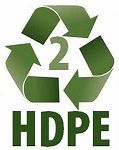
High-density polyethylene is a type of plastic made from petroleum. Its sometimes called alcathene or polythene when used for pipes. Has a resin identification number of 2.
Characteristics of HDPE
- It has a high strength to density ratio.
- Can tolerate high temperatures, not as high as PET and strong chemicals.
- It is harder and opaque as compared to PET.
Typical uses of HDPE : Milk bottles, bleach, cleaners and most shampoo bottles.
Environmental Impact : Low impact, highly recyclable.
3. PVC
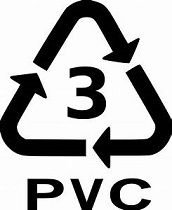
Polyvinyl chloride was accidentally synthesized by German Chemist Eugene Baumann. Its produced by polymerization of the vinyl chloride monomer (VCM). Let's get into the chemistry of this...shall we? JUST KIDDING!!, I don't want to bore you with bonds and chemical reactions. PVC has a resin identification number of 3.
Characteristics of PVC
- Has high hardness and mechanical properties.
- As raw PVC, its heat stability is very poor. Heat additives are added to improve its ability.
- Has very good insulation properties hence its use as an electrical insulator.
- Its chemically resistant to acids, salts, bases, fats, and alcohol, makes it suitable for sewage pipes.
Typical uses of PVC: Electrical Insulation material, plumbing fittings, toys, tablecloths, shower curtains, deli meat wraps, cleaner bottles.
Environmental Impact: Hazard. When heated it releases toxic fumes and chemicals that can leach into food. NEVER NEVER heat in the microwave food wrapped in PVC plastic.
4. LDPE
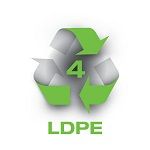
Characteristics of LDPE
- It can withstand temperatures of 80 degC to 95 degC without degrading.
- Its resistant to impact (doesn't break easily.
- It's waterproof and resistant to chemicals.
- It's quite flexible and tough.
Typical uses of LDPE: Electrical Insulation material, dry cleaning bags, bread bags, garbage liners, produce bags.
Environmental Impact: Low impact, highly recyclable.
5. PP
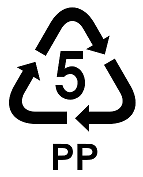
Characteristics of PP
- Its resistant to acids and bases making it suitable for cleaning agent products, first-aid products.
- Its shape after a lot of torsion, bending, and/or flexing. Ever seen plastic hinges? That's PP plastic.
- It has a high resistance to electricity hence useful in making electronic components.
- Has a varied range melting point 130 - 170 degC depending on the polypropylene. At 0 deg it becomes brittle.
Typical uses of PP : Pill bottles, Bottle caps, straws, yoghurt tub, margerine tub
Environmental Impact : Low Hazard, highly recyclable
6. PS
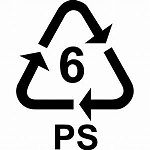
Characteristics of PS
- It has a low melting point. Ever tried burning that packaging that comes with TVs, Music Systems?
- In its raw state it's translucent, colorants are added to give different variations of polystyrene.
- It's slow to break down.
- It can be solid or foamed.
Typical uses of PS: Typically referred to as styrafoam and is used in cups, plates, take-out containers, coolers, packaging peanuts.
Environmental Impact :Hazard, styrene can leach from polystyrene. This can lead to nervous system damage and cancer. Highly non-biodegradable.
7. Other

Typical Uses of Other: Baby bottles and “sippy” cups, baby food jars, 5-gallon water bottles, “sport” water bottles, plastic dinnerware and clear plastic cutlery.
Conclusion
Now that you know your plastics you can better protect yourself and the environment. In conclusion below are some safety tips.
- Know the code: Look at the bottom of the plastic to see the number, codes 1,2,4 and 5 are consider safest while 3 and 6 should be avoided as they leach harmful chemicals.
- Reconsider heating plastics in the microwave. Get ceramic bowls or containers labelled as microwave safe for this purpose.
- Use the plastic for it's intended purpose. Code 1 plastics are single-use plastics meaning they are designed to be used only once.
- Don't freeze: Unless plastic is labelled as freeze safe, don't. Once frozen most plastics become brittle and easily break leaking into food.
STAY WOKE PEOPLE!!!
References
- PET or PETE
Ecostar Plastics:PET, Creative Mechanicims: PET or PETE - HDPE
Wikipedia:HDPE, BPF:HDPE, eplactics:HDPE - PVC
PVC.org, Wikipedia:PVC - LDPE
Plastics Make It Possible:LDPE, Wikipedia:LDPE - PP
PP:Wikipedia, British Plastic Federation;Polypropylene, Creative Mechanicims: PP Plastics - PS
Chemical Safety Post:Polystyrene, Reference.com:Polystyrene - Other
The Amaizing Medicine
Image Sources
Know Your PlasticsPET logo, HDPE logo, PVC logo, LDPE logo, Polypropylene logo, Polystyrene logo, Other

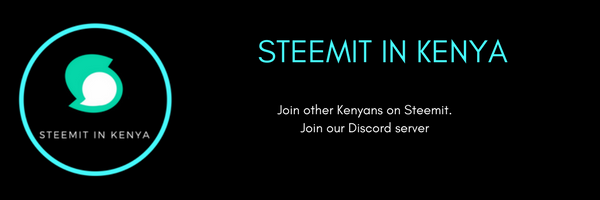

You got a 33.33% upvote from @greengrowth thanks to @cmbugua! You too can use @GreenGrowth by sending your post URL in the memo field to the bot. Minimum bid is 0.01.
If you feel this post is spammy or not worthy of @Greengrowth you can contact a moderator in our Discord Channel https://discord.gg/6DhnVTQ.
Downvoting a post can decrease pending rewards and make it less visible. Common reasons:
Submit
Great work
Downvoting a post can decrease pending rewards and make it less visible. Common reasons:
Submit
Thank you for the info. Do you think plastics should be banned in Kenya? What would be the alternative?
Downvoting a post can decrease pending rewards and make it less visible. Common reasons:
Submit
Banning isn't the solution, alternatives are there and we haven't exhausted or tried anything. Bio-plastics made from plant material with high amounts of starch even sea weed and some algae make bio-plastics are a great alternative, they use less energy to make and are degradable.
Another thing is why cant community run recyclying centers be set up? Imagine one at the Dandora dump site, the possibilities, we can produce energy from the waste and it be sold creating income for the residents.
Thank you for stopping by always a pleasure.
Downvoting a post can decrease pending rewards and make it less visible. Common reasons:
Submit
Great post! Thank you!
Downvoting a post can decrease pending rewards and make it less visible. Common reasons:
Submit
Thank you my friend for stopping by, still waiting for a new article on the blue economy.
Downvoting a post can decrease pending rewards and make it less visible. Common reasons:
Submit
I didn't know there were so many types. Thank you for this information. I am a tad happy we banned the plastic bags in Kenya. Seems like one step towards the right direction. The information you have provided here is very useful.
Downvoting a post can decrease pending rewards and make it less visible. Common reasons:
Submit
Congratulations! This post has been upvoted from the communal account, @minnowsupport, by cmbugua from the Minnow Support Project. It's a witness project run by aggroed, ausbitbank, teamsteem, theprophet0, someguy123, neoxian, followbtcnews, and netuoso. The goal is to help Steemit grow by supporting Minnows. Please find us at the Peace, Abundance, and Liberty Network (PALnet) Discord Channel. It's a completely public and open space to all members of the Steemit community who voluntarily choose to be there.
If you would like to delegate to the Minnow Support Project you can do so by clicking on the following links: 50SP, 100SP, 250SP, 500SP, 1000SP, 5000SP.
Be sure to leave at least 50SP undelegated on your account.
Downvoting a post can decrease pending rewards and make it less visible. Common reasons:
Submit
Very informative piece. I'm from Kenya and new in steem. Kindly send me a link to join discord to share and see more articles by fellow Kenyans. Thanks and hope you follow me back...:)
Downvoting a post can decrease pending rewards and make it less visible. Common reasons:
Submit
Thank you for the comment. Welcome to steemit @dutchesswanga, here is the link to Kenya's discord group: https://discord.gg/W6u4cr Karibu, join the team and introduce yourself.
Downvoting a post can decrease pending rewards and make it less visible. Common reasons:
Submit
You just planted 0.10 tree(s)!
Thanks to @skycae
We have planted already 5773.94 trees
out of 1,000,000
Let's save and restore Abongphen Highland Forest
in Cameroonian village Kedjom-Keku!
Plant trees with @treeplanter and get paid for it!
My Steem Power = 20677.44
Thanks a lot!
@martin.mikes coordinator of @kedjom-keku
Downvoting a post can decrease pending rewards and make it less visible. Common reasons:
Submit